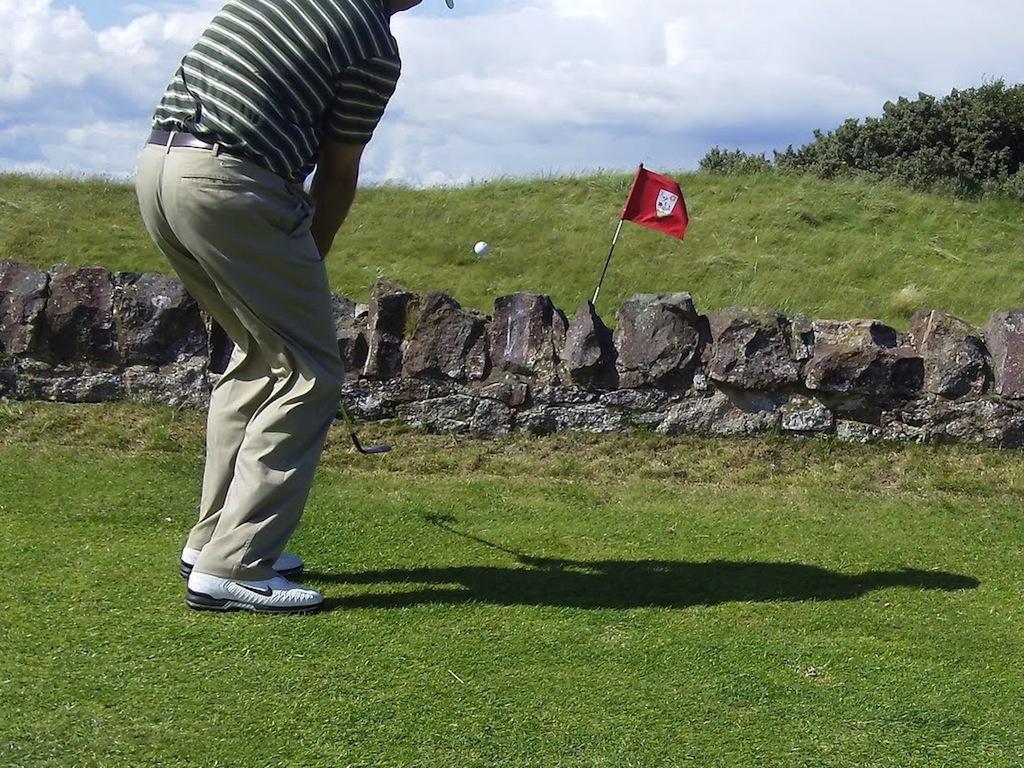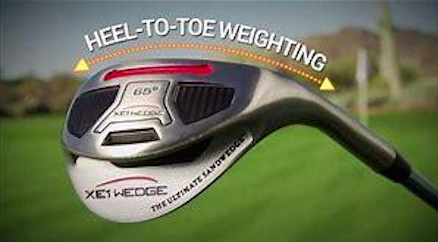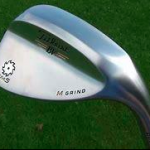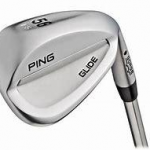Instruction
Confessions of a hacker: Chipping yips and equipment fixes

There’s a saying in golf that, paraphrasing here, it’s the person holding the weapon, not the weapon. Basically, if you hit a bad shot, it’s almost certain that it was your fault, not the fault of the golf club. It has a better design than your swing. And while that truism is often correct, it ain’t necessarily so.
For example, if I were to try to hit one of those long drive drivers, I’d probably mis-hit it so badly that the ball might not be findable. That stick is way too long, stiff, and heavy for me. Similarly, if I were to use one of those senior flex drivers, I’d probably hit it badly, because it would be too floppy for my swing. It’s clear that there are arrows that this Indian can’t shoot well. Maybe a pro could adapt to whatever club you put in his hand, but there’s no reason he would accept less than a perfect fit. And there’s little reason why any amateur ought to accept less than a good fit.
I was never a competitive athlete, although I’m a competitive person. My path led a different direction, and as my medical career reached its mature years, I was introduced to our wonderful and frustrating game.
Being one who hates playing poorly, I immediately sought instruction. After fifteen years, multiple instructors, a wallet full of videos, and a wall full of clubs, I am finally learning how to do one particularly vexing part of the game reasonable well. I can chip! But as you may have guessed, the largest part of this journey has to do with the arrow, not the Indian.
We may immediately dismiss the golf shaft as a significant issue since chipping generally involves a low-speed movement. And as long as the grip is a reasonable fit for the hands, it’s not a big deal either. The rubber meets the road at the clubhead.
Manufacturers have worked hard to get the best ball spin out of the grooves. Their shape is precisely milled, and then smaller grooves and roughness are added to the exact maximum allowed under the rules. Various weighting schemes have been tried, with some success in tailoring wedges to players. And some manufacturers market the “newest” designs to make it impossible to screw up wedge shots. And yet, nothing seemed to solve my yips.

So I went on a mission. I studied all sorts of chipping techniques. Some advocate placing the ball far back to strike a descending blow. Others place it near the center of the stance. The swing must have no wrist hinge. The swing must have a hinge that is held. It should be a short swing. It should be a long swing. The face should be square. The face should be open. There should be a “pop.” There should be no power added.
If you are confused, join my club. So I went on a different mission. I started looking at sole construction. Ever since Gene Sarazen popularized a sole with bounce for use in the sand, manufacturers have been creating massive numbers of “different” sand wedges. They have one thing in common. They are generally all built to 55 or 56-degrees of loft.
The basic design feature of the sand wedge is that the sole extends down and aft from the leading edge at some angle. This generally ranges from 6 to 18-degrees. Its purpose is to allow the wedge to dig into the sand, but not too far. As the club goes down into the sand, the “bounce” pushes it back up.

One problem with having a lot of bounce on the wedge is that it can’t be opened up to allow certain specialty shots or have a higher effective loft. When the player does that, the leading edge lifts, resulting in thin shots. So manufacturers do various things to make the wedge more versatile, typically by removing bounce in the heel area.
- Titleist M Grind
- Titleist M Grind Wide Sole
- Callaway PM Grind
- Ping Glide
At my last count, I have eight 56-degree wedges in my collection. Each one was thought to be a solution to my yips. Yet, until I listened to an interview with Dave Edel, I had almost no real understanding of why I was laying sod over a lot of my chips. Since gardening did not reduce my scores, I had to find another solution.
My first step was to look at the effective loft of a wedge in various ball positions. (Pictures were shot with the butt of the club at the left hip, in a recommended forward lean position. Since the protractor is not exactly lined up with the face, the angles are approximate.)

I had no idea that there was so much forward lean with a simple chip. If I were to use the most extreme rearward position, I would have to have 21-degrees of bounce just to keep the leading edge from digging in at impact. If there were the slightest error in my swing, I would be auditioning for greenskeeper.
My appreciation for the pros who can chip from this position suddenly became immense. For an amateur like me, the complete lack of forgiveness in this technique suddenly removed it from my alleged repertoire.
My next step was to look at bounce. As I commented before, bounce on sand wedges ranges between 6 and 18-degrees. As the drawing above shows, that’s a simple angle measurement. If I were to chip from the forward position, a 6-degree bounce sand wedge would have an effective bounce of 1-degree. That’s only fractionally better than the impossible chip behind my right foot. So I went to my local PGA Superstore to look at wedges with my Maltby Triangle Gauge in hand.

As you can see from the photos, there is a wide variation in wedges. What’s most curious, however, is that this variation is between two designs that are within one degree of the same nominal bounce. Could it be that “bounce is not bounce is not bounce?” Or should I say that “12-degrees is not 12-degrees is not 12-degrees?” If one looks below the name on the gauge, a curious bit of text appears. “Measuring effective bounce on wedges.” Hmmm… What is “effective bounce?”
The Maltby Triangle Gauge allows you to measure three things: leading-edge height, sole tangent point, and leading-edge sharpness. The last is the most obvious. If I’m chipping at the hairy edge of an adequate bounce, a sharp leading edge will dig in more easily than a blunt one. So if I’m using that far back ball position, I’ll need the 1OutPlus for safety, since its leading edge is the bluntest of the blunt. Even in that position, its 11-degree bounce keeps the leading edge an eighth of an inch up.
Wait a minute! How can that be? In the back position, the wedge is at 35-degrees effective loft, and 11-degrees of bounce ought to be 10-degrees less than we need. The difference here is found in combining all three parameters measured by the gauge, and not just the angle of the bounce.
The 1OutPlus is a very wide sole wedge. Its tangent point is a massive 1.7″ back. The leading edge rises .36″ off the ground and is very blunt. In other words, it has every possible design feature to create safety in case the chip from back in the stance isn’t as perfect as it might be. Since a golf ball is 1.68″ in diameter, that’s still less than halfway up to the center of the ball. But if you play the ball forward, this may not be the wedge for you.
Here are the measurements for the eight sand wedges that happen to be in my garage. All are either 56-degrees from the factory or bent to 56-degrees.

A couple of things jump out from this table. The Callaway PM Grind at 13-degrees has a lower leading edge (.26 inches) than the 11-degree Bazooka 1OutPlus (.36 inches). How can a lower bounce have a higher leading edge? Simple geometry suggests that if you want a higher leading edge, you will need a higher bounce angle. But it gets worse. The Wishon WS (wide sole) at 6-degrees (55-degree wedge bent to 56-degrees) has a leading-edge height of .28 inches, higher than the Callaway which has over twice the nominal bounce angle!
One thing is missing from this simple discussion of angles.
If I place one line at 34-degrees above the horizontal (loft is measured from the vertical), and then extend another at some angle below horizontal, the height above ground where the two join depends on how long the lower line is. This means that an 18-degree bounce with a narrow “C” grind will raise the leading edge a little bit. A 6-degree bounce on a wide sole may raise it more because the end of the bounce on the first wedge is so close to the leading edge.

Let’s look at this in the picture. If the red line of the bounce is very short, it doesn’t get far below the black ground line. But if it goes further, it gets lower. This is the difference between narrow and wide soles.
This diagram describes the mathematical description of these relationships.

Our first task is to realize that the angle 0 in this diagram is the complement of the 56-degree loft of the wedge, or 90 – 56 = 34-degrees since loft is measured from vertical, not horizontal. But the angle 0 in the bounce equation is just that, the bounce value. These two angles will now allow us to calculate the theoretical values of various parts of the wedge, and then compare them to our real-world examples.
My PM Grind Callaway wedge has its 3rd groove, the supposed “perfect” impact point, 0.54 inches above the leading edge. This should put it 0.8 inches back from the leading edge, roughly matching the measured 0.82 inches. So far, so good. (I’m using the gauge correctly!)
The 13-degree bounce at 1.14″ calculates out to 0.284″ of leading-edge rise. I measured 0.26″, so Callaway seems to be doing the numbers properly, until I realize that the leading edge is already .45″ back, given a real tangent of .69″. Something is out of whack. Re-doing the math suggests that the real bounce is 20-degrees, 40 min. Hmmm…
Maybe that bounce angle measurement isn’t such a good number to look at. Without digging through all the different wedges (which would make you cross-eyed), we should go back to basics. What is it that we really need?
Most instructors will suggest that striking the ball on about the third groove will give the best results. It will put the ball close to the center of mass (sweet spot) of the wedge and give the best spin action. If my wedge is at an effective 45-degree angle (about my right big toe), it will strike the ball about half-way up to its equator. It will also be close to the third groove. But to make that strike with minimal risk of gardening, I have to enough protection to keep the edge out of the turf if I mis-hit the ball by a little bit. That can be determined by the leading edge height! The higher the edge, the more forgiveness there is on a mis-hit.
Now this is an incomplete answer. If the bounce is short, with a sharp back side, it will tend to dig into the turf a bit. It may not do it a lot, but it will have more resistance than a wider, smoother bounce. In the extreme case, the 1OutPlus will simply glide over the ground on anything less than a ridiculous angle.
The amount of leading-edge height you need will depend on your style. If you play the ball forward, you may not need much. But as you move the ball back, you’ll need to increase it. And if you are still inconsistent, a wider sole with a smooth contour will help you avoid episodes of extreme gardening. A blunt leading edge will also help. It may slow your club in the sand, but it will protect your chips.
There is no substitute for practice, but if you’re practicing chips from behind your right foot using a wedge with a sharp, low leading edge, you’re asking for frustration. If you’re chipping from a forward position with a blunt, wide sole wedge, you’ll be blading a lot of balls. So look at your chipping style and find a leading-edge height and profile that match your technique. Forget about the “high bounce” and “low bounce” wedges. That language doesn’t answer the right question.
Get a wedge that presents the club to the ball with the leading edge far enough off the ground to provide you with some forgiveness. Then knock ’em stiff!
Instruction
The Wedge Guy: Beating the yips into submission

There may be no more painful affliction in golf than the “yips” – those uncontrollable and maddening little nervous twitches that prevent you from making a decent stroke on short putts. If you’ve never had them, consider yourself very fortunate (or possibly just very young). But I can assure you that when your most treacherous and feared golf shot is not the 195 yard approach over water with a quartering headwind…not the extra tight fairway with water left and sand right…not the soft bunker shot to a downhill pin with water on the other side…No, when your most feared shot is the remaining 2- 4-foot putt after hitting a great approach, recovery or lag putt, it makes the game almost painful.
And I’ve been fighting the yips (again) for a while now. It’s a recurring nightmare that has haunted me most of my adult life. I even had the yips when I was in my 20s, but I’ve beat them into submission off and on most of my adult life. But just recently, that nasty virus came to life once again. My lag putting has been very good, but when I get over one of those “you should make this” length putts, the entire nervous system seems to go haywire. I make great practice strokes, and then the most pitiful short-stroke or jab at the ball you can imagine. Sheesh.
But I’m a traditionalist, and do not look toward the long putter, belly putter, cross-hand, claw or other variation as the solution. My approach is to beat those damn yips into submission some other way. Here’s what I’m doing that is working pretty well, and I offer it to all of you who might have a similar affliction on the greens.
When you are over a short putt, forget the practice strokes…you want your natural eye-hand coordination to be unhindered by mechanics. Address your putt and take a good look at the hole, and back to the putter to ensure good alignment. Lighten your right hand grip on the putter and make sure that only the fingertips are in contact with the grip, to prevent you from getting to tight.
Then, take a long, long look at the hole to fill your entire mind and senses with the target. When you bring your head/eyes back to the ball, try to make a smooth, immediate move right into your backstroke — not even a second pause — and then let your hands and putter track right back together right back to where you were looking — the HOLE! Seeing the putter make contact with the ball, preferably even the forward edge of the ball – the side near the hole.
For me, this is working, but I am asking all of you to chime in with your own “home remedies” for the most aggravating and senseless of all golf maladies. It never hurts to have more to fall back on!
Instruction
Looking for a good golf instructor? Use this checklist

Over the last couple of decades, golf has become much more science-based. We measure swing speed, smash factor, angle of attack, strokes gained, and many other metrics that can really help golfers improve. But I often wonder if the advancement of golf’s “hard” sciences comes at the expense of the “soft” sciences.
Take, for example, golf instruction. Good golf instruction requires understanding swing mechanics and ball flight. But let’s take that as a given for PGA instructors. The other factors that make an instructor effective can be evaluated by social science, rather than launch monitors.
If you are a recreational golfer looking for a golf instructor, here are my top three points to consider.
1. Cultural mindset
What is “cultural mindset? To social scientists, it means whether a culture of genius or a culture of learning exists. In a golf instruction context, that may mean whether the teacher communicates a message that golf ability is something innate (you either have it or you don’t), or whether golf ability is something that can be learned. You want the latter!
It may sound obvious to suggest that you find a golf instructor who thinks you can improve, but my research suggests that it isn’t a given. In a large sample study of golf instructors, I found that when it came to recreational golfers, there was a wide range of belief systems. Some instructors strongly believed recreational golfers could improve through lessons. while others strongly believed they could not. And those beliefs manifested in the instructor’s feedback given to a student and the culture created for players.
2. Coping and self-modeling can beat role-modeling
Swing analysis technology is often preloaded with swings of PGA and LPGA Tour players. The swings of elite players are intended to be used for comparative purposes with golfers taking lessons. What social science tells us is that for novice and non-expert golfers, comparing swings to tour professionals can have the opposite effect of that intended. If you fit into the novice or non-expert category of golfer, you will learn more and be more motivated to change if you see yourself making a ‘better’ swing (self-modeling) or seeing your swing compared to a similar other (a coping model). Stay away from instructors who want to compare your swing with that of a tour player.
3. Learning theory basics
It is not a sexy selling point, but learning is a process, and that process is incremental – particularly for recreational adult players. Social science helps us understand this element of golf instruction. A good instructor will take learning slowly. He or she will give you just about enough information that challenges you, but is still manageable. The artful instructor will take time to decide what that one or two learning points are before jumping in to make full-scale swing changes. If the instructor moves too fast, you will probably leave the lesson with an arm’s length of swing thoughts and not really know which to focus on.
As an instructor, I develop a priority list of changes I want to make in a player’s technique. We then patiently and gradually work through that list. Beware of instructors who give you more than you can chew.
So if you are in the market for golf instruction, I encourage you to look beyond the X’s and O’s to find the right match!
Instruction
What Lottie Woad’s stunning debut win teaches every golfer

Most pros take months, even years, to win their first tournament. Lottie Woad needed exactly four days.
The 21-year-old from Surrey shot 21-under 267 at Dundonald Links to win the ISPS Handa Women’s Scottish Open by three shots — in her very first event as a professional. She’s only the third player in LPGA history to accomplish this feat, joining Rose Zhang (2023) and Beverly Hanson (1951).
But here’s what caught my attention as a coach: Woad didn’t win through miraculous putting or bombing 300-yard drives. She won through relentless precision and unshakeable composure. After watching her performance unfold, I’m convinced every golfer — from weekend warriors to scratch players — can steal pages from her playbook.
Precision Beats Power (And It’s Not Even Close)
Forget the driving contests. Woad proved that finding greens matters more than finding distance.
What Woad did:
• Hit it straight, hit it solid, give yourself chances
• Aimed for the fat parts of greens instead of chasing pins
• Let her putting do the talking after hitting safe targets
• As she said, “Everyone was chasing me today, and managed to maintain the lead and played really nicely down the stretch and hit a lot of good shots”
Why most golfers mess this up:
• They see a pin tucked behind a bunker and grab one more club to “go right at it”
• Distance becomes more important than accuracy
• They try to be heroic instead of smart
ACTION ITEM: For your next 10 rounds, aim for the center of every green regardless of pin position. Track your greens in regulation and watch your scores drop before your swing changes.
The Putter That Stayed Cool Under Fire
Woad started the final round two shots clear and immediately applied pressure with birdies at the 2nd and 3rd holes. When South Korea’s Hyo Joo Kim mounted a charge and reached 20-under with a birdie at the 14th, Woad didn’t panic.
How she responded to pressure:
• Fired back with consecutive birdies at the 13th and 14th
• Watched Kim stumble with back-to-back bogeys
• Capped it with her fifth birdie of the day at the par-5 18th
• Stayed patient when others pressed, pressed when others cracked
What amateurs do wrong:
• Get conservative when they should be aggressive
• Try to force magic when steady play would win
• Panic when someone else makes a move
ACTION ITEM: Practice your 3-6 foot putts for 15 minutes after every range session. Woad’s putting wasn’t spectacular—it was reliable. Make the putts you should make.
Course Management 101: Play Your Game, Not the Course’s Game
Woad admitted she couldn’t see many scoreboards during the final round, but it didn’t matter. She stuck to her game plan regardless of what others were doing.
Her mental approach:
• Focused on her process, not the competition
• Drew on past pressure situations (Augusta National Women’s Amateur win)
• As she said, “That was the biggest tournament I played in at the time and was kind of my big win. So definitely felt the pressure of it more there, and I felt like all those experiences helped me with this”
Her physical execution:
• 270-yard drives (nothing flashy)
• Methodical iron play
• Steady putting
• Everything effective, nothing spectacular
ACTION ITEM: Create a yardage book for your home course. Know your distances to every pin, every hazard, every landing area. Stick to your plan no matter what your playing partners are doing.
Mental Toughness Isn’t Born, It’s Built
The most impressive part of Woad’s win? She genuinely didn’t expect it: “I definitely wasn’t expecting to win my first event as a pro, but I knew I was playing well, and I was hoping to contend.”
Her winning mindset:
• Didn’t put winning pressure on herself
• Focused on playing well and contending
• Made winning a byproduct of a good process
• Built confidence through recent experiences:
- Won the Women’s Irish Open as an amateur
- Missed a playoff by one shot at the Evian Championship
- Each experience prepared her for the next
What this means for you:
• Stop trying to shoot career rounds every time you tee up
• Focus on executing your pre-shot routine
• Commit to every shot
• Stay present in the moment
ACTION ITEM: Before each round, set process goals instead of score goals. Example: “I will take three practice swings before every shot” or “I will pick a specific target for every shot.” Let your score be the result, not the focus.
The Real Lesson
Woad collected $300,000 for her first professional victory, but the real prize was proving that fundamentals still work at golf’s highest level. She didn’t reinvent the game — she simply executed the basics better than everyone else that week.
The fundamentals that won:
• Hit more fairways
• Find more greens
• Make the putts you should make
• Stay patient under pressure
That’s something every golfer can do, regardless of handicap. Lottie Woad just showed us it’s still the winning formula.
FINAL ACTION ITEM: Pick one of the four action items above and commit to it for the next month. Master one fundamental before moving to the next. That’s how champions are built.
PGA Professional Brendon Elliott is an award-winning coach and golf writer. You can check out his writing work and learn more about him by visiting BEAGOLFER.golf and OneMoreRollGolf.com. Also, check out “The Starter” on RG.org each Monday.
Editor’s note: Brendon shares his nearly 30 years of experience in the game with GolfWRX readers through his ongoing tip series. He looks forward to providing valuable insights and advice to help golfers improve their game. Stay tuned for more Tips!














numbersnerd
Aug 13, 2020 at 5:03 pm
Overwrought analysis. With that many numbers floating around in your head, no wonder you have the yips.
geohogan
Aug 8, 2020 at 11:37 am
absolutely nothing here addressing , chipping yips.
coops1967
Sep 5, 2020 at 5:13 am
No, but here’s some actually useful advice
https://forums.golfwrx.com/topic/1737218-chipping-woes-cure/?tab=comments#comment-22922750
geohogan
Nov 5, 2020 at 8:47 pm
Useful for setting up to hit a chip, but nothing about what causes YIPS.
Actually Malaska’s erroneous full swing advise, misquoting Jack Nicklaus
was more suitable to cure chipping YIPS.
Jack’s actual advise : “It’s impossible to release the club too early in the downswing — as long as you move to your left side and swing the club from inside the target line.”
If applied to chipping this is good advise to eliminate the YIPS.
https://www.golfdigest.com/story/flick-nicklaus-release